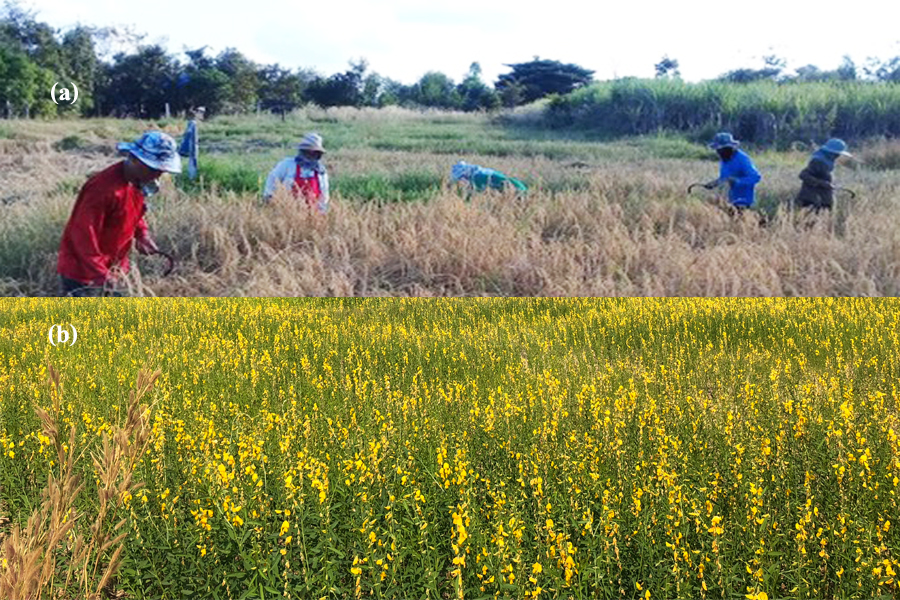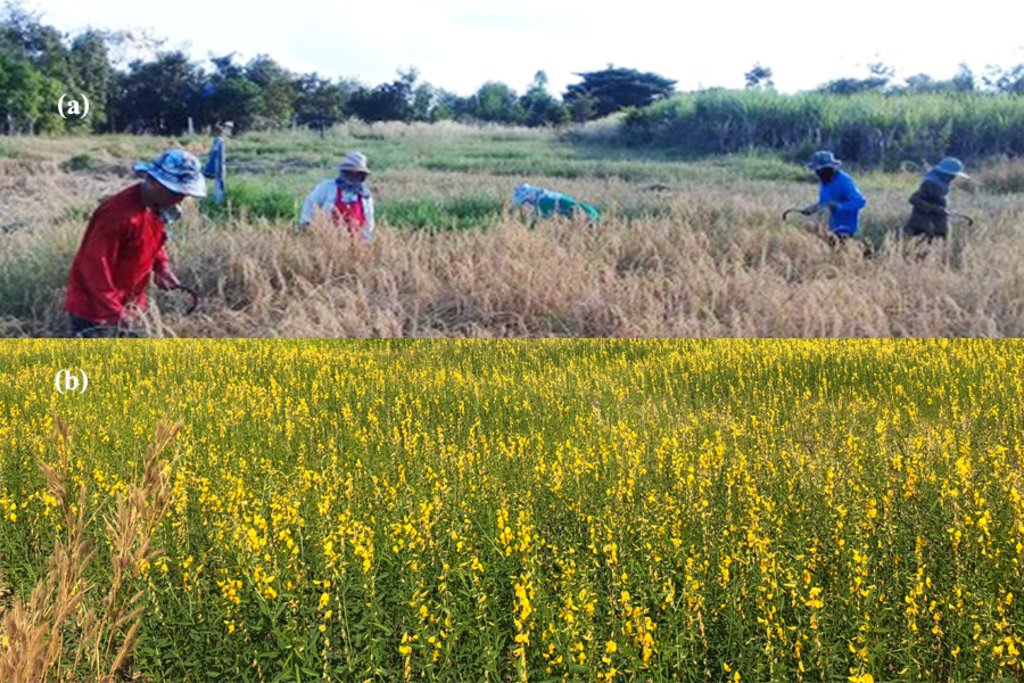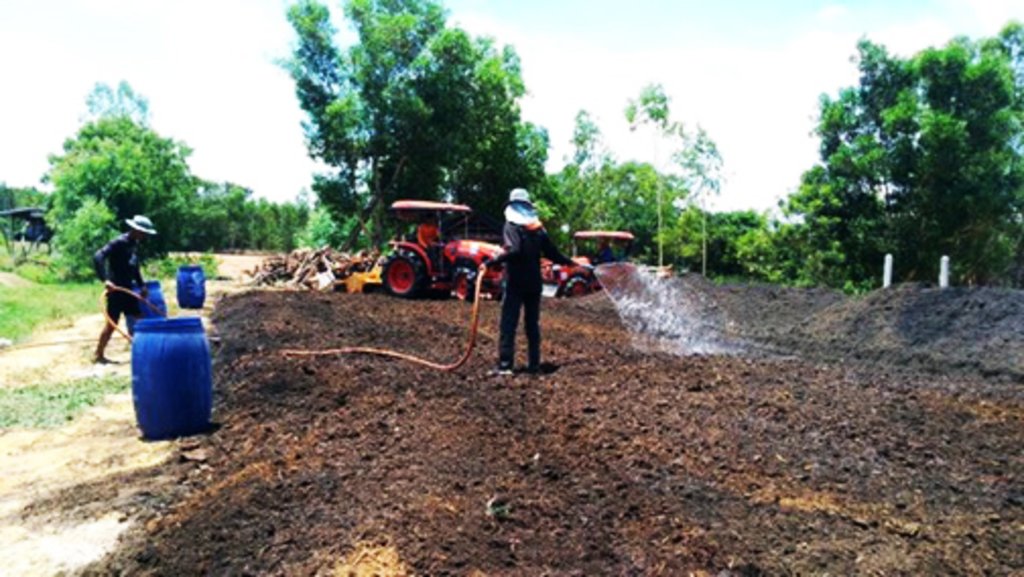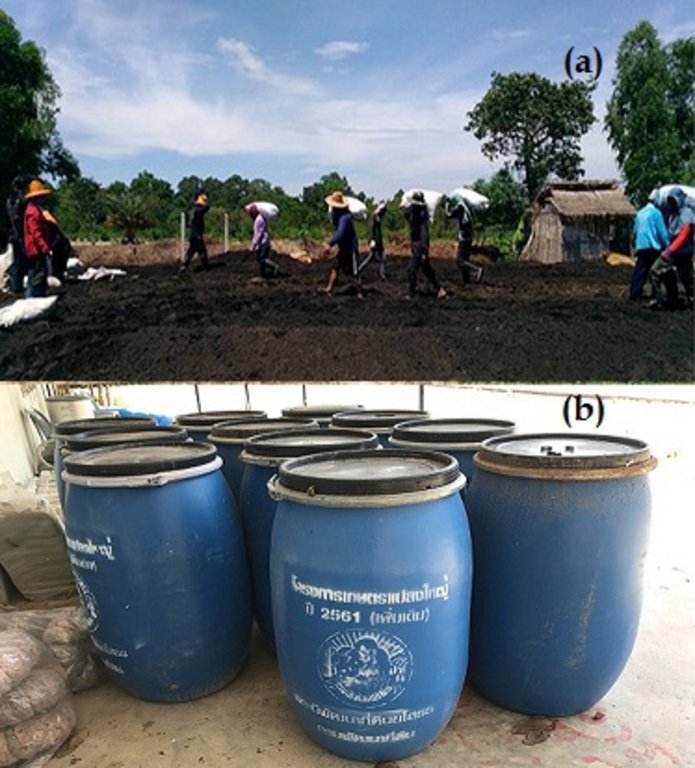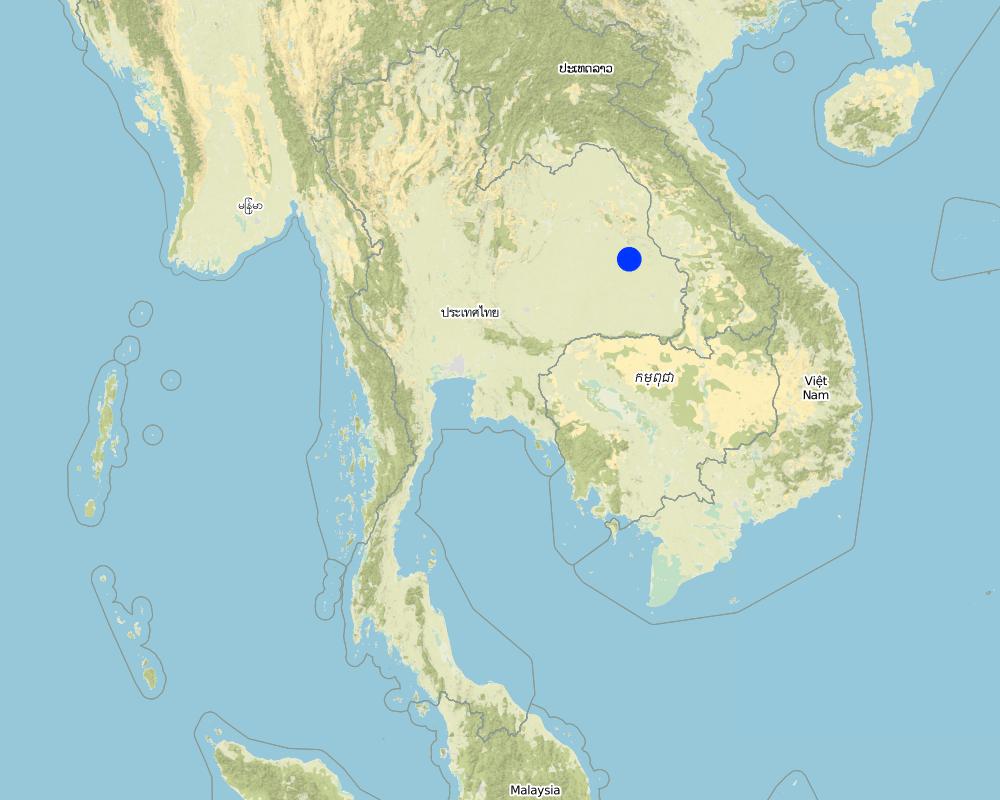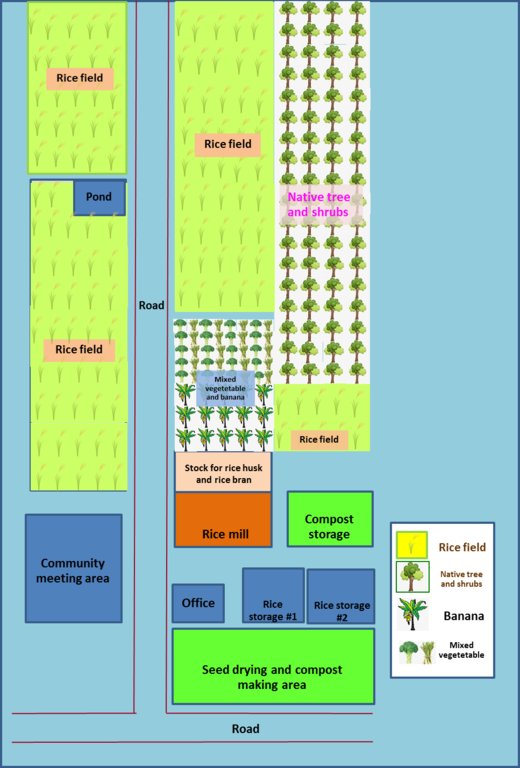Use of Organic Fertilizers for Organic Crop Pproduction on Infertile Soil [تايلاند]
- تاريخ الإنشاء:
- تحديث:
- جامع المعلومات: Suwannapa B00njongrak
- المحرر: –
- المراجعون: Rima Mekdaschi Studer, Samran Sombatpanit
technologies_4176 - تايلاند
عرض الأقسام
توسيع الكل طي الكل1. معلومات عامة
1.2 تفاصيل الاتصال بالأشخاص الرئيسيين لمصدر المعلومات والمؤسسات المشاركة في تقييم وتوثيق التقنية
الشخص (الأشخاص) الرئيسي لمصدر المعلومات
متخصص في الإدارة المستدامة للأراضي:
Namsai Yuthasong
متخصص في الإدارة المستدامة للأراضي:
Suthakum Ratana
تايلاند
متخصص في الإدارة المستدامة للأراضي:
Kaoya Putchanee
تايلاند
national consultant:
Arunin Somsri
Land Development Department
تايلاند
اسم المشروع الذي سهّل توثيق/تقييم التقنية (إذا كان ذلك على صلة)
Decision Support for Mainstreaming and Scaling out Sustainable Land Management (GEF-FAO / DS-SLM)اسم المؤسسة (المؤسسات) التي سهلت توثيق/تقييم التقنية (إذا كان ذلك على صلة)
Land Development Department LDD (Land Development Department LDD) - تايلاند1.3 الشروط المتعلقة باستخدام البيانات الموثقة من خلال WOCAT
يوافق جامع المعلومات والشخص (لاشخاص) الرئيسي لمصدر المعلومات على الشروط المتعلقة باستخدام البيانات الموثقة من خلال WOCAT:
نعم
1.4 إعلان بشأن استدامة التقنية الموصوفة
هل التقنية الموصوفة هنا تمثل مشكلة فيما يتعلق بتدهور الأراضي، بحيث لا يمكن إعلانها تقنية مستدامة لإدارة الأراضي؟:
كلا
التعليقات:
This is the main technology supporting organic farming which is the process accepted by the whole world because it concerns the food stability and security.
1.5 الإشارة إلى الاستبيان (الاستبيانات) حول مناهج الإدارة المستدامة للأراضي (موثقة باستخدام WOCAT)
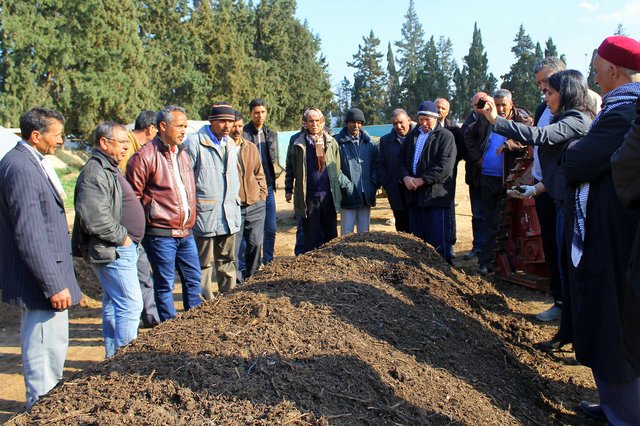
Immense demande de valorisation des déchets et amélioration … [تونس]
Une immense demande de la technique du compostage comme une solution environmentale et écologique pour la gestion des déchets et un traitement obligatoire des dechets organiques en agriculture biologique.
- جامع المعلومات: Donia Mühlematter
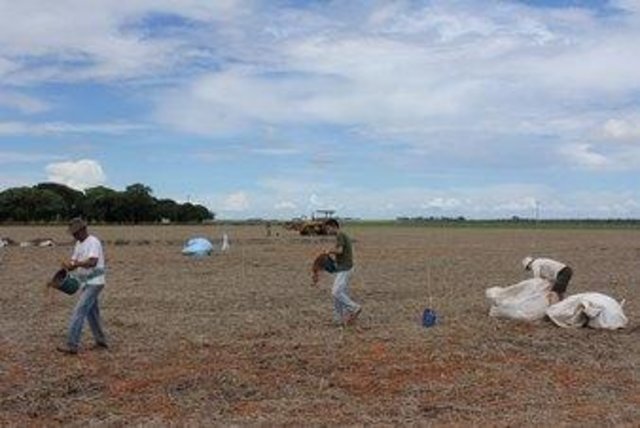
Enrichment of Tropical Agricultural Soil with Organic Matter [البرازيل]
Enrichment of tropical agicultural soils with local available organic matter in the cerrado agroscape, Brazil.
- جامع المعلومات: Luisa F. Vega
2. وصف تقنيةالإدارة المستدامي للأراضي
2.1 وصف مختصر للتقنية
تعريف التقنية:
The organic farming was initiated by a group of Yasothon farmers since 1989 to produce organic rice and vegetables. The organic fertilizers used are the compost made from farm products and animal dungs, bio-fermented liquid from kitchen wastes and crotalaria as green manure.
2.2 وصف تفصيلي للتقنية
الوصف:
Organic farming has become a national agenda with cross collaboration among government organizations concerned, local community administration, private sectors and farmers. This technology has scaled up to 253 farmers on 6,000 rai (6.25 rai = 1 ha) at Ban Sokkompoon, Naso Sub-district, Kutchum District, Yasothon Province. The information has been received from Mr. Man Samsee, chief of the community and a farmer himself. The organic fertilizers used in the farmers’ fields are the compost from farm products and animal dungs, bio-fermented liquid from kitchen wastes, fermented liquid from neem (Azadirachta indica) for pest control, and green manure from Crotalaria juncia. The crops grown have been rice and vegetables, medicinal herbs and sesame, which are certified as organic products; they command higher prices (more than 20%). Compost is the main organic fertilizer compared to others.
The objectives of organic farming are to produce organic crops, improve soil fertility, reduce wastes for friendly environment, get higher income and enhance good health for both producers and consumers. The procedure of making compost: The materials used for making compost are 1,000 kg of burnt rice husk, 3,000 kg of cattle manure/poultry manure, 3,000 kg of farm residues, 1,000 kg of coarse bran, 500 kg of fine bran, 1,000 kg of rice husk and 500 liters of organic-fermented liquid, all being thoroughly mixed by using a tractor. The allocation of compost: an amount of 300 kg of compost (20 bags) is given to each member to ferment at the farm by turning the bags occasionally before applying to a 3-rai land. There are several government organizations and private sectors that support this community of farmers, and a learning center was thus established. Up to now, the Land Development Department has been providing the knowledge of making compost and bio-fertilizer liquid; It also has been distributing green mature seeds and activators of bacteria and fungi. The Department of Agricultural Extension provided funding to establish the learning and training center and to produce materials used for training together with private sectors under CSR (Corporate Social Responsibility). The Cooperative Promotion Department supported by keeping household accounts. The local community administration set up several market places and promoted the products to be purchased by hospitals and restaurants. The organic crop products have been certified by OACT (Organic Agriculture Certification of Thailand) and IFOAM (International Federation of Organic Agriculture Movements). The Department of Groundwater provided groundwater by drilling holes at 30-40 m deep. The Department of Alternative Energy Development and Efficiency provided solar cells as the source of energy. The noticeable benefit of organic farming is that farmers have better health, the soil has become more fertile and the expenditure decreased. The farmers have been satisfied of their own lifestyle and did not migrate to the city. They have been committed to developing their land by using organic fertilizers continuously. The average income has increased from 7,500 THB/rai to 12,000 THB/rai. The main problem has been the transportation of the organic fertilizers which are bulky, but it can be overcome by producing them on site where needed.
2.3 صور التقنية
ملاحظات عامة بخصوص الصور:
Farmers are carrying compost bags allocated to them for their own use.
2.4 فيديوهات عن التقنية
التاريخ:
28/11/2018
2.5 البلد/المنطقة/المواقع التي تم تنفيذ التقنية فيها والتي يغطيها هذا التقييم
البلد:
تايلاند
المنطقة/الولاية/المحافظة:
Yasothon
مزيد من التفاصيل حول الموقع:
Ban Naso, Naso Sub-district, Kutchum District, Yasothon Province, Thailand
حدد انتشار التقنية:
- منتشرة بالتساوي على مساحة
إذا كانت التقنيةا موزعة بالتساوي على منطقة ما، حدد المساحة المغطاة (بالكيلومتر المربع):
960,0
إذا كانت المساحة الدقيقة غير معروفة، فيرجى الإشارة إلى المنطقة التقريبية المغطاة:
- 1,000-100 كم2
هل يقع موقع/مواقع التقنية في منطقة محمية بشكل دائم؟:
كلا
التعليقات:
This area is rather flat, approx. 0-2% slope and thus no soil erosion. The fertility of the soil is low.
Map
×2.6 تاريخ التنفيذ
اذكر سنة التنفيذ:
1989
في حالة عدم معرفة السنة بالتحديد، يرجى الإشارة إلى التاريخ التقريبي:
- منذ 10-50 سنة
2.7 إدخال التقنية
حدد كيف تم إدخال التقنية:
- من خلال ابتكار مستخدمي الأراضي
- The land user got knowledge from training abroad.
3. تصنيف تقنية الإدارة المستدامي للأراضي
3.1 الغرض الرئيسي ( الأغراض الرئيسية) للتقنية
- تحسين الإنتاج
- الحد من تدهور الأراضي ومنعه وعكسه
- خلق أثر اقتصادي مفيد
3.2 نوع (أنواع) استخدام الأراضي الحالية حيث يتم تطبيق التقنية
استخدامات الأراضي مختلطة ضمن نفس وحدة الأرض:
كلا

الأراضي الزراعية
- زراعة سنوية
الزراعة السنوية - حدد المحاصيل:
- الحبوب - الأرز (الأراضي الرطبة)
عدد مواسم الزراعة في السنة:
- 1
حدد:
Khao Dok Mali 105 rice variety (Jasmine Rice)
هل يتم ممارسة الزراعة البينية؟:
كلا
هل تتم ممارسة تناوب المحاصيل؟:
كلا
3.3 هل تغير استخدام الأراضي نتيجة لتنفيذ التقنية؟
هل تغير استخدام الأراضي نتيجة لتنفيذ التقنية؟:
- لا (تابع مع السؤال 3.4)
استخدامات الأراضي مختلطة ضمن نفس وحدة الأرض:
كلا

الأراضي الزراعية
3.4 إمدادات المياه
إمدادات المياه للأرض التي يتم تنفيذ التقنية عليها:
- بعلية
التعليقات:
The rainfall in this area was 1,562 mm/yr in 30-year period (1981-2010).
3.5 مجموعةالإدارة المستدامة للأراضي التي تنتمي إليها هذه التقنية
- الإدارة المتكاملة للمحاصيل والثروة الحيوانية
- تحسين الغطاء الأرضي/النباتي
- الإدارة المتكاملة لخصوبة التربة
3.6 التدابير التقنية في مجال إلادارة المستدامة للأراضي

التدابير الزراعية
- A2: المادة العضوية/خصوبة التربة
3.7 الأنواع الرئيسية من تدهور الأراضي التي تناولتها التقنية

التدهور الكيميائي للتربة
- (Cn): تراجع الخصوبة وانخفاض محتوى المادة العضوية (غير ناتج عن الانجراف)

التدهور المادي أو الفيزيائي للتربة
- (Pu): فقدان الوظيفة الإنتاجية الحيوية بسبب أنشطة أخرى

التدهور البيولوجي
- (Bc): تناقص الغطاء النباتي
التعليقات:
The land degradation has been caused by man, e.g. deforestation, the overuse of agricultural chemical substances.
3.8 منع أو حد أو عكس تدهور الأراضي
تحديد هدف التقنية فيما يتعلق بتدهور الأراضي:
- منع تدهور الأراضي
- الحد من تدهور الأراضي
التعليقات:
The organic fertilizer/ compost could improve soil structure, reduce bulk density, increase soil aeration, easy to plough, decrease the hard pan and spread out the plant roots. Consequently, plant roots could absorb more nutrients.
4. المواصفات الفنية، وأنشطة التنفيذ، والمدخلات، والتكاليف
4.1 الرسم الفني للتقنية
المواصفات الفنية (المتعلقة بالرسم الفني):
The method of making compost of Naso Rice Farmer Group can be described as follows: 1) the ingredients are 1,000 kg of chicken manure, 1,000 kg of cattle manure, 1,000 kg of poultry manure, 1,000 kg of top soil, 500 liter of bio-fermented liquid and 1,000 kg of filter cake; 2) mix all of these ingredients and pack in the bags; 3) distribute these bags to the members for making compost at their home; and 4) when the compost decomposes completely, it can be applied in paddy fields at the rate of 1,280 kg/rai (8,000 kg/ha).
المؤلف:
Miss Kanokwan Hansookjaichareon
التاريخ:
09/10/2018
4.2 معلومات عامة بخصوص حساب المدخلات والتكاليف
حدد كيفية احتساب التكاليف والمدخلات:
- حسب مساحة تنفيذ التقنية
الإشارة إلى حجم ووحدة المساحة:
1 rai
في حالة استخدام وحدة مساحة محلية، قم بالإشارة إلى عامل التحويل إلى هكتار واحد (على سبيل المثال، 1 هكتار = 2.47 فدان): 1 هكتار =:
1 ha = 6.25 rai
عملة أخرى/ عملة وطنية (حدد):
THB
إذا كان ذا صلة، وضح سعر الصرف من الدولار الأمريكي إلى العملة المحلية (على سبيل المثال، 1 دولار أمريكي = 79.9 ريال برازيلي): 1 دولار أمريكي =:
32,0
اذكر متوسط تكلفة أجر العمالة المستأجرة في اليوم الواحد:
300 THB
4.3 أنشطة التأسيس
| النشاط | التوقيت (الموسم) | |
|---|---|---|
| 1. | Gathering the materials | December-April |
| 2. | Making compost | December-April |
| 3. | Applying to paddy field | May-June |
التعليقات:
The kinds of materials may differ according to the amount of residues at that time.
4.4 التكاليف والمدخلات اللازمة للتأسيس
| تحديد المدخلات | الوحدة | الكمية | التكاليف لكل وحدة | إجمالي التكاليف لكل مدخل | % من التكاليف التي يتحملها مستخدمو الأراضي | |
|---|---|---|---|---|---|---|
| العمالة | Labour for making compost | Man-day | 8,0 | 300,0 | 2400,0 | |
| معدات | Tractor | hour | 2,5 | 1250,0 | 3125,0 | |
| معدات | Transportation cost | hour | 1,5 | 350,0 | 525,0 | |
| المواد النباتية | Animal manures, burned rice husk, bran | kg | 10000,0 | 0,655 | 6550,0 | |
| إجمالي تكاليف إنشاء التقنية | 12600,0 | |||||
| إجمالي تكاليف إنشاء التقنية بالدولار الأمريكي | 393,75 | |||||
إذا تحمل مستخدم الأرض أقل من 100% من التكاليف، حدد من قام بتغطية التكاليف المتبقية:
Naso Rice Farmer Group
4.5 الصيانة/الأنشطة المتكررة
| النشاط | التوقيت/الوتيرة | |
|---|---|---|
| 1. | Turn the compost bags during fermentation process. | Every week until 75 days |
4.6 التكاليف والمدخلات اللازمة للصيانة/للأنشطة المتكررة (سنويًا)
| تحديد المدخلات | الوحدة | الكمية | التكاليف لكل وحدة | إجمالي التكاليف لكل مدخل | % من التكاليف التي يتحملها مستخدمو الأراضي | |
|---|---|---|---|---|---|---|
| العمالة | Turn the compost bags during fermentation process | Day | 1,0 | 300,0 | 300,0 | |
| إجمالي تكاليف صيانة التقنية | 300,0 | |||||
| إجمالي تكاليف صيانة التقنية بالدولار الأمريكي | 9,38 | |||||
إذا تحمل مستخدم الأرض أقل من 100% من التكاليف، حدد من قام بتغطية التكاليف المتبقية:
Land Development Department
4.7 أهم العوامل المؤثرة على التكاليف
قدم وصفا لأهم العوامل التي تؤثر على التكاليف:
Most of the costs depend on raw material price and wages cost (both labour and equipment)
5. البيئة الطبيعية والبشرية
5.1 المناخ
هطول الأمطار السنوي
- < 250 مم
- 251- 500 ملم
- 501 - 750ملم
- 1,000-751 ملم
- 1,500-1,100 ملم
- 2,000-1,500 ملم
- 3,000-2,001 ملم
- 4,000-3,100 ملم
- > 4000 ملم
حدد متوسط هطول الأمطار السنوي (إذا كان معروفًا)، بالملليمتر:
1600,00
المواصفات/التعليقات على هطول الأمطار:
There are 3 seasons in Yasothon, i.e. hot, rainy, and cool seasons. The average relative humidity is 71.1%. Maximum temperature is 42 degree celsius, minimum temperature is 11 degree celsius.
الإشارة إلى اسم محطة الأرصاد الجوية المرجعية المعنية:
Meteorological Department
المنطقة المناخية الزراعية
- شبه قاحلة
5.2 طوبوغرافيا
متوسط الانحدارات:
- مسطح (0-2%)
- بسيط (3-5%)
- معتدل (6-10%)
- متدحرج (11-15%)
- تلال (16-30%)
- شديدة الانحدار(31-60%)
- فائقة الانحدار (>60%)
التضاريس:
- هضاب/سهول
- أثلام مرتفعة
- المنحدرات الجبلية
- منحدرات التلال
- منحدرات في السفوح
- قاع الوادي
المنطقة الارتفاعية:
- 100-0 متر فوق سطح البحر
- 500-101 متر فوق سطح البحر
- 1,000-501 متر فوق سطح البحر
- 1,500-1,001 متر فوق سطح البحر
- 2,000-1,501 متر فوق سطح البحر
- 2,500-2,100 متر فوق سطح البحر
- 3,000-2,501 متر فوق سطح البحر
- 4,000-3,001 متر فوق سطح البحر
- > 4000 متر فوق سطح البحر
وضح ما إذا كانت التقنية مطبقة على وجه التحديد في:
- غير ذات صلة
5.3 التربة
متوسط عمق التربة:
- ضحل جدًا (0-20 سم)
- ضحلة (21-50 سم)
- متوسطة العمق (51-80 سم)
- عميقة (81-120 سم)
- عميقة جدًا (> 120 سم)
قوام التربة (التربة السطحية):
- متوسط ( طميي، سلتي)
قوام التربة (> 20 سم تحت السطح):
- متوسط ( طميي، سلتي)
المواد العضوية في التربة السطحية:
- منخفضة (<1%)
5.4 توافر المياه ونوعيتها
منسوب المياه الجوفية:
50-5 م
توافر المياه السطحية:
جيد
نوعية المياه (غير المعالجة):
للاستخدام الزراعي فقط (الري)
تشير جودة المياه إلى:
المياه السطحية
هل تعتبر ملوحة الماء مشكلة؟:
كلا
هل تحدث فيضانات في المنطقة؟:
كلا
5.5 التنوع البيولوجي
تنوع الأنواع:
- متوسط
تنوع الموائل:
- متوسط
5.6 خصائص مستخدمي الأراضي الذين يطبقون التقنية
مستقر أو مرتحل:
- غير المترحل
التوجه السوقي لنظام الإنتاج:
- مختلط (كفاف/ تجاري)
الدخل من خارج المزرعة:
- أقل من % 10من كامل الدخل
المستوى النسبي للثروة:
- ثري
أفراداً أو مجموعات:
- فرد/أسرة معيشية
مستوى المكننة:
- عمل يدوي
- ميكانيكية/ مزودة بمحرك
الجنس:
- رجال
عمر مستخدمي الأرضي:
- كبار السن
5.7 متوسط مساحة الأرض التي يستخدمها مستخدمو الأراضي الذين يطبقون التقنية
- < 0.5 هكتارا
- 0.5 - 1 هكتار
- 1 -2 هكتار
- 2 - 5 هكتار
- 5 - 15 هكتار
- 15 - 50 هكتار
- 50 - 100هكتار
- 500-100 هكتار
- 1,000-500 هكتار
- 10,000-1,000 هكتار
- > 10,000 هكتار
هل يعتبر هذا نطاقًا صغيرًا أو متوسطًا أو واسعا (في إشارة إلى السياق المحلي)؟:
- على نطاق متوسط
التعليقات:
The holding areas of the land users in the Northeast of Thailand are about 3.2-4.8 ha per household.
5.8 ملكية الأراضي، وحقوق استخدام الأراضي، وحقوق استخدام المياه
ملكية الارض:
- فردية، يوجد سند ملكية
حقوق استخدام الأراضي:
- وصول مفتوح (غير منظم)
حقوق استخدام المياه:
- فردي
هل تعتمد حقوق استخدام الأراضي على نظام قانوني تقليدي؟:
نعم
التعليقات:
The land owners have full right in their land, so they are able to manage and develop their land.
5.9 الوصول إلى الخدمات والبنية التحتية
الصحة:
- ضعيف
- معتدل
- جيد
التعليم:
- ضعيف
- معتدل
- جيد
المساعدة التقنية:
- ضعيف
- معتدل
- جيد
العمل (على سبيل المثال خارج المزرعة):
- ضعيف
- معتدل
- جيد
الأسواق:
- ضعيف
- معتدل
- جيد
الطاقة:
- ضعيف
- معتدل
- جيد
الطرق والنقل:
- ضعيف
- معتدل
- جيد
مياه الشرب وخدمات الصرف الصحي:
- ضعيف
- معتدل
- جيد
الخدمات المالية:
- ضعيف
- معتدل
- جيد
6. الآثار والتصريحات الختامية
6.1 الآثار التي أظهرتها التقنية في الموقع
الآثار الاجتماعية والاقتصادية
الإنتاج
إنتاج المحاصيل
جودة المحاصيل
جودة الغابات/الأراضي الحرجية
إدارة الأراضي
الدخل والتكاليف
النفقات على المدخلات الزراعية
دخل المزرعة
تنوع مصادر الدخل
عبء العمل
الآثار الاجتماعية والثقافية
الأمن الغذائي / الاكتفاء الذاتي
الوضع الصحي
استخدام الأراضي / حقوق المياه
الفرص الثقافية
الفرص الترفيهية
المؤسسات المجتمعية
المؤسسات الوطنية
المعرفة بالإدارة المستدامة للأراضي/تدهور الأراضي
وضع الفئات المحرومة اجتماعيا واقتصاديا
الآثار الايكولوجية
دورة المياه / الجريان السطحي
جودة المياه
الجريان السطحي
تصريف المياه الزائدة
مستوى المياه الجوفية/ الطبقة المائية الجوفية
التبخر
التربة
رطوبة التربة
غطاء التربة
تراكم التربة
تكون قشرة التربة السطحية/انسداد مسام التربة
تراص التربة
دورة المغذيات/إعادة الشحن
الملوحة
المادة العضوية في التربة/تحت الطبقة c
الحموضة
التنوع البيولوجي: الغطاء النباتي، الحيوانات
الغطاء النباتي
الكتلة الحيوية/ طبقة الكربون فوق التربة
التنوع النباتي
الأنواع الدخيلة الغازية
التنوع الحيواني
الأنواع المفيدة
تنوع الموائل
الحد من مخاطر المناخ والكوارث
انبعاث الكربون والغازات المسببة للاحتباس الحراري
6.2 الآثار التي أظهرتها التقنية خارج الموقع
تدفقات مائية موثوقة ومستقرة في موسم الجفاف
الفيضان في اتجاه مجرى النهر
تلوث المياه الجوفية/الأنهار
القدرة على التخفيف / الترشيح
آثار الغازات الدفيئة
6.3 تعرض التقنية وحساسيتها لتغير المناخ التدريجي والظواهر المتطرفة/الكوارث المرتبطة بالمناخ (كما يراها مستخدمو الأراضي)
تغير مناخ تدريجي
تغير مناخ تدريجي
| الموسم | زيادة أو نقصان | كيف تتعامل التقنية مع ذلك؟ | |
|---|---|---|---|
| درجة الحرارة السنوية | زيادة | باعتدال | |
| درجة الحرارة الموسمية | الصيف | زيادة | باعتدال |
| درجة الحرارة الموسمية | موسم الرطوبة/ الأمطار | زيادة | باعتدال |
| هطول الأمطار السنوي | زيادة | باعتدال |
الظواهر المتطرفة / الكوارث المرتبطة بالمناخ
الكوارث الجوية
| كيف تتعامل التقنية مع ذلك؟ | |
|---|---|
| عاصفة ممطرة محلية | باعتدال |
| عاصفة رعدية محلية | باعتدال |
| عاصفةبَرَد محلية | باعتدال |
الكوارث المناخية
| كيف تتعامل التقنية مع ذلك؟ | |
|---|---|
| جفاف | باعتدال |
الكوارث البيولوجية
| كيف تتعامل التقنية مع ذلك؟ | |
|---|---|
| أمراض وبائية | باعتدال |
| الإصابة بالحشرات/الديدان | باعتدال |
العواقب الأخرى المتعلقة بالمناخ
العواقب الأخرى المتعلقة بالمناخ
| كيف تتعامل التقنية مع ذلك؟ | |
|---|---|
| فترة نمو ممتدة | باعتدال |
| انخفاض فترة النمو | باعتدال |
التعليقات:
The changes of environment have rather low effects to organic fertilizer production technology.
6.4 تحليل التكلفة والعائد
كيف يمكن مقارنة العوائد نسبة لتكاليف الإنشاء (من وجهة نظر مستخدمي الأراضي)؟
عوائد قصيرة الأجل:
إيجابي قليلا
عوائد طويلة الأجل:
إيجابي
التعليقات:
There are no maintenance expenses on this technology because it is consumable.
6.5 اعتماد التقنية
- حالات فردية/تجريبية
من بين جميع الذين تبنوا التقنية، كم عدد الذين فعلوا ذلك بشكل تلقائي، أي دون تلقي أي حوافز مادية/مدفوعات؟:
- 51-90%
6.6 التكيف
هل تم تعديل التقنية مؤخرًا لتتكيف مع الظروف المتغيرة؟:
نعم
أخرى (حدد):
changing upon materials in the local area
حدد تكيف التقنية(التصميم، المواد/الأنواع، الخ.):
The materials for making compost might be changed; for example, filter cake might be changed to water hyacinth or other aqua weeds.
6.7 نقاط القوة / المزايا / الفرص التي توفرها التقنية
| نقاط القوة/ المزايا/ الفرص من وجهة نظر مستخدمي الأراضي |
|---|
| The organic fertilizers are suitable for soil improvement, thus increasing soil fertility. |
| The use of organic fertilizers can reduce the use of chemical fertilizers. |
| It is a wise alternative to use agricultural residues to obtain more benefits. |
| Develop bargaining power to sell the products. |
| نقاط القوة/ المزايا/ الفرص من وجهة نظر جامع المعلومات أو غيره من الاشخاص الرئيسيين لمصدر المعلومات |
|---|
| The farmers have high leadership and high self-reliance. |
| The farmers have multi-knowledge which can be adapted to the farm activities. |
| The organic fertilizer is the key factor for organic farming. |
| The organic fertilizer can promote the utilization of local residues sustainably. |
6.8 نقاط ضعف / مساوىء / مخاطر التقنية وسبل التغلب عليها
| نقاط الضعف/ المساوىء/ المخاطر من وجهة نظر مستخدم الأراضي | كيف يمكن التغلب عليها؟ |
|---|---|
| The organic fertilizer transportation is a hard work. | The organic fertilizer can be produced in paddy fields. |
| نقاط الضعف/ المساوىء/ المخاطر من وجهة نظر جامع المعلومات أو غيره من الاشخاص الرئيسيين لمصدر المعلومات | كيف يمكن التغلب عليها؟ |
|---|---|
| Some farmers do not have the confidence in using organic fertilizer. | Responsible persons are urged to do more in the matter of technology transfer to effectively increase the understanding of farmers. |
7. المراجع والروابط
7.1 طرق جمع/مصادر المعلومات
- زيارات ميدانية، مسوحات ميدانية
16 land users, 1 local administrator, 1 miller, 1 farmer leader
- مقابلات مع مستخدمي الأراضي
56 farmers
- مقابلات مع المتخصصين/الخبراء في الإدارة المستدامة للأراضي
2 informants
متى تم تجميع البيانات (ميدانيا)؟:
10/10/2018
التعليقات:
Interviews started 10/10/2018 - 2/11/2018
7.2 المراجع للمنشورات المتاحة
العنوان، المؤلف، السنة، النظام القياسي الدولي لترقيم الكتب ISBN:
Organic fertilizer, production, using, and quality. Department of Agriculture. 2005. ISBN 974-436-479-3
متاح من أين؟كم التكلفة؟:
http://aglib.doa.go.th/lib/images/Downloads/2549/EB00280.pdf
7.3 روابط للمعلومات ذات الصلة على الإنترنت
العنوان/الوصف:
Organic fertilizer, production, using, and quality. Department of Agriculture. 2005. ISBN 974-436-479-3
عنوان الرابط URL:
http://aglib.doa.go.th/lib/images/Downloads/2549/EB00280.pdf
7.4 تعليقات عامة
where the land is greener : WOCAT
الروابط والوحدات المواضيعية
توسيع الكل طي الكلالروابط

Immense demande de valorisation des déchets et amélioration … [تونس]
Une immense demande de la technique du compostage comme une solution environmentale et écologique pour la gestion des déchets et un traitement obligatoire des dechets organiques en agriculture biologique.
- جامع المعلومات: Donia Mühlematter

Enrichment of Tropical Agricultural Soil with Organic Matter [البرازيل]
Enrichment of tropical agicultural soils with local available organic matter in the cerrado agroscape, Brazil.
- جامع المعلومات: Luisa F. Vega
الوحدات المواضيعية
لا يوجد وحدات مواضيعية


